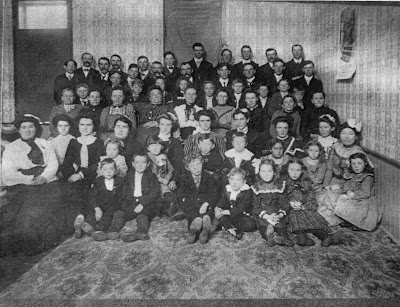A history of Woodburn would not be complete without a history of the town of Ottawa, as this small town was the forerunner of Woodburn. In fact, many of the buildings at Ottawa were moved to Woodburn when that town sprung up as a result of the western movement of the railroad. The railroad followed the natural valley which was about a mile south of Ottawa, resulting in the demise of Ottawa.
In 1854 Benjamin Coppock and his brother, Lindsay, came to Clarke County and entered land. Benjamin had 200 acres and Lindsay 160 acres, the town of Ottawa being founded on Benjamin’s 200 acres. At the time the Coppock brothers arrived in the county, there was only one house between them and the town of Osceola. On May 2, 1855, Benjamin and Catharine Coppock deeded land to the town of Ottawa on sections 14 and 23. The town plat shows a layout with nine blocks, the center one being a public square. Lots were 132 feet deep and most were 66 feet wide with streets that were also 66 feet wide.
The Ottawa Post Office was established June 30, 1855, and operated until 1867. Catharine Coppock sold land on August 18, 1855, to School District Two for the Ottawa school. This school was located on lot 8, block 7, and was built of logs. Methodist Church services were held in the school after its construction. The first known church services were held by the Methodist denomination in the Lindsay Coppock home in 1854. Their minister was Rev. Allen Johnson, of Chariton. The first Catholic priest, Father Michael, passed through the community on a trip further west in 1858 and celebrated Mass in the home of John McDonough.
Dr. T.S. Harding located in Ottawa in 1857 or 1858, and carried on farming and practicing medicine until his death in 1882. He was also something of a preacher. During the Civil War, Dr. Calvin Blythe located at Ottawa, and later continued his practice at Woodburn.
In 1870, businesses listed in section 14 of Jackson Township were A.S. Funk, lumber dealer and merchant; J.W. Wright, wagon and carriage manufacturer. By this time, the town of Ottawa was but a few buildings, most of them having been removed to the new town of Woodburn. A survey of Ottawa in 1875 shows a far less grandiose town than originally planned.
In later years at the Ottawa site, there was a barbershop operated by John DeVore; a restaurant operated at different times by these people: Andy and Cleo Gwinn, Harold Stearns, and Mervin and Marilea Poths; a gas station (Sinclair for several years, later Conoco) operated by Bernard Baker, Russell Page - who purchased it in 1931, Wilbert “Gup” Smith, Monty and Marge Grimm, 1961-1962, and later Donny Hall. The gas station was a building that had been moved in from Jay. This gas station was the last remaining business, and was later used as a repair shop by Donny Hall, then as a feed store operated by Randy Wright and finally by Rex Marker. Hon Riley had an implement store at Ottawa.
The old U.B. Church was on the southwest side of the intersection between Hwy. 34 and R69, down the road from the intersection. It had been used as a community building after services were discontinued and dances were held there. They also brought in a portable platform that was used as a skating rink by the church. The church was bought by Earl Mason in 1931 and made into his garage business. Herman Ewoldsen had a filling station in this southwest corner also - it was farther west on what is now Hwy. 34. The switchboard office, the Ottawa Telephone Office, was run by Fern Mason DeVore out of their home in this corner section also. The switchboard was located in the middle of their living room. This was a 24 hour a day job and someone always had to be there. They had 20 lines and each customer on the line had their own numbers of long and short rings made by turning the crank on the switchboard and moving the switch to control the length of ring.
Ottawa area girls
Back - Mary Chambers, Laura Mumford, Maude Smith, Verna Westbrook
Front - _______________ , Dolly Page, Sylvia Smith, Jess Clark.
United Brethren Church Congregation
Back - starting with second man over, against wall - ______________, ________________, _______________, Sam Page, ______________, _____ Chambers, Ed Johnson, M.S. (Simeon) Clark. Row 6 - ________Chambers, Bill Johnson, Charles Smith, Tom Page, Nathan Root, Pearl Johnson, _________________, Bill Forster, Oscar Carson.Row 5 – start with young boy behind woman – fifth one over on Nathan Root’s lap is Ruth Root, Mary Root, Chambers boy.
Row 4 – Martha Carson, _______________, ________________, ____________________, Matt Carson (Jim’s wife), Sarah Mumford, Mary Smith, Laura Belle Clark, __________________, ___________________.
Row 3 – starting with woman to far left side – Lizzie Johnson, Bessie Pownell (slightly behind Liz and Dolly), Dolly Page, Louella Rodgers, May Mackey, Sylvia Smith, Pollie Mackey, Mary “Mame” Clark, Mary Ellen Johnson, _______________.
Row 2 – starting with small girl - ______________________, _________________, _______________, Floyd Page, Verna Barton, Meta Johnson, Carrie Johnson (woman with large bow), _____________________.
Front – Manny Clark, Russell Page, __________________, _________________, ____________________, Bertha Mumford.
Cleo Gwinn





1 comment:
Thanks for the history. TS Harding was my great great grandfather. He came to Iowa from Virginia, where he had been a Methodist preacher who opposed slavery. His mother was a practitioner of herbal medicine, which he learned from her.
Doug Harding
Post a Comment